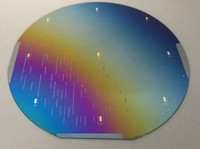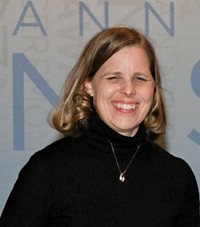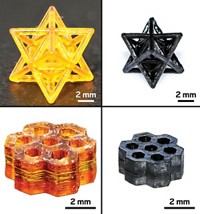Advertisement
Grab your lab coat. Let's get started
Welcome!
Welcome!
Create an account below to get 6 C&EN articles per month, receive newsletters and more - all free.
It seems this is your first time logging in online. Please enter the following information to continue.
As an ACS member you automatically get access to this site. All we need is few more details to create your reading experience.
Not you? Sign in with a different account.
Not you? Sign in with a different account.
ERROR 1
ERROR 1
ERROR 2
ERROR 2
ERROR 2
ERROR 2
ERROR 2
Password and Confirm password must match.
If you have an ACS member number, please enter it here so we can link this account to your membership. (optional)
ERROR 2
ACS values your privacy. By submitting your information, you are gaining access to C&EN and subscribing to our weekly newsletter. We use the information you provide to make your reading experience better, and we will never sell your data to third party members.
Materials
New complex alloys push the limits of materials
Unorthodox high-entropy alloys open a world of possibility, but discovering them is the challenge
by Neil Savage, special to C&EN
October 3, 2021
| A version of this story appeared in
Volume 99, Issue 36

The first time that materials scientist Brian Cantor took a stab at mixing a lot of different elements together was in 1980. Then a lecturer at the University of Sussex, Cantor wondered why metallurgists focused only on tweaking recipes for established metal alloys or refining synthesis processes. “Why is it we’ve never had lots of components together?” he asked. “People kept saying, ‘That is daft.’ ”
But he thought it was worth a try. So he went to the cabinet where his lab stored its various metal samples, selected 20 he thought might go together, and persuaded an undergraduate researcher, Alain Vincent, to melt and mix them.
756
Number of transition-metal dichalcogenide combinations that Rohan Mishra’s group simulated while searching for electrocatalyst candidates
This initial attempt didn’t produce a usable alloy. Neither did mixing smaller sets of 16 or 10 metals, though the effort did contribute to Vincent’s bachelor’s thesis. Eventually Cantor, who had moved to the University of Oxford, and other colleagues repeated the experiments and jump-started a new field when they published the research online in 2003 (Mater. Sci. Eng., A, DOI: 10.1016/j.msea.2003.10.257). A separate paper published a few months later by Jien-Wei Yeh, a materials scientist at National Tsing Hua University, gave these materials their name: high-entropy alloys (HEAs) (Adv. Eng. Mat. 2004, DOI: 10.1002/adem.200300567).
“I would have loved to have discovered [the new alloy] on the basis of really fundamental theory or a really inspired bit of creative experimentation,” says Cantor, now a professor emeritus at Oxford. “The truth is it was a random bit of serendipity.”
The concept of HEAs—also called multicomponent alloys, multiprincipal component alloys, or compositionally complex alloys—is a huge shift in how people make alloys, which have served humanity since the Bronze Age. All traditional alloys consist of one base element with just a small percentage of another element or two mixed in. For example, bronze is mainly copper, with a mass fraction of about 12% tin, and maybe a pinch of aluminum or nickel. If you feel like making brass, mix copper and zinc. Steel is iron with a soupçon of carbon.
But if you limit alloys to one main component, “we’ve used them all up,” says Daniel Miracle, a materials scientist at the US Air Force Research Laboratory. “The last element that was used as an alloy base was titanium in the 1950s and 1960s, and after that we ran out of bases.”
HEAs differ from traditional alloys in that no one element dominates. Instead, they’re combinations—often, but not always, in equal proportions—of four or more metallic elements. Given that perhaps 60 or 70 elements could be added to the recipe, “There’s just a gazillion materials to discover,” Cantor says. And the possibilities grow as the field expands beyond metals to include oxides and ceramics.
Although Cantor started by throwing combinations of elements into a furnace to see what came out, that random strategy is unlikely to help materials scientists efficiently explore the vast space of potential HEAs. So researchers are turning to computational methods and machine learning to help narrow down the candidates. They are also developing new methods for high-throughput screening that may help them characterize the materials’ properties. But many of these screening tools remain experimental and are not yet widely available, posing a big challenge to researchers eager to map this vast unknown territory.
Cool new combos
Yeh named the new materials high-entropy alloys because of his realization that combining many elements changes the thermodynamic factors that drive the formation of different phases in the materials. In a given crystalline solid, atoms of a particular element can arrange into phases, or regions, with their own crystalline structures. Intermetallic phases are those for which two or more elements form an ordered structure. The various phases affect a material’s macroscopic properties, such as strength, ductility, and hardness. Increasing the number of elements adds more entropy—intrinsic disorder—to the materials and changes the kinds of crystal structures they form. Further analysis has shown that entropy is only part of the reason—and not always the dominant one—why the alloys turn out as they do, but the name has stuck.
Few metallurgists before Cantor and Yeh saw any promise in combining so many elements, because the intermetallic regions tend to make the alloys more brittle. But Cantor and colleagues found areas within the alloys they made where a single phase predominated. That phase consisted of five metals: iron, chromium, manganese, nickel, and cobalt, each at 20 atomic percent and arranged in a face-centered-cubic (fcc) crystal structure. The material and other single-phase fcc alloys made of three or more components have been dubbed “Cantor alloys.” Not only do they combine high strength and ductility, but they also have the unusual attribute of getting tougher at ultracold temperatures, when most materials become increasingly brittle. One test pegged a three-element Cantor alloy as 273 times as tough as silicon at liquid nitrogen temperatures (Nat. Commun. 2016, DOI: 10.1038/ncomms10602).
Such promising mechanical properties are what make HEAs appealing as a source of new structural materials. Aerospace engineers, for instance, would like turbines that don’t melt above about 1,250 °C so engines can run hotter and more efficiently. Tough materials that are more lightweight would be appealing for airplanes and automobiles. Other applications would benefit from better resistance to corrosion or embrittlement by hydrogen. In fact, more efficient catalysts, photovoltaics, thermoelectrics, or battery materials (J. Mater. Chem. A 2021, DOI: 10.1039/D0TA09578H) could have an even bigger societal impact, Miracle says, and screening for some of those functional properties may be easier than for mechanical properties.
Phases of discovery
Computational screening can help narrow down the search area for new alloys, Miracle says. First, it’s important to know what properties you’re looking for—density, cost, melting temperature, and so on. The trick then is to apply tests that will eliminate the largest number of candidates with the least effort. In one study looking for high-temperature structural materials for aerospace applications, Miracle used thermodynamic calculations to reduce the number of potential materials by three orders of magnitude (CALPHAD: Comput. Coupling Phase Diagrams Thermochem. 2015, DOI: 10.1016/j.calphad.2015.04.009). “In a few weeks of calculations, we went from 135,000 candidates to only 160,” he says.
That computational approach uses a tool called calculation of phase diagrams (CALPHAD) to predict the phase structures of alloys at different temperatures, pressures, and compositions. CALPHAD uses experimental data from existing, well-characterized alloys to predict those conditions for other materials. Not surprisingly, those predictions are more accurate for materials for which there are already a lot of data.

To address the challenge of building phase diagrams for new, many-element alloys, Joseph Poon, a professor of physics and materials science at the University of Virginia, and his graduate student Jie Qi decided to use binary phase diagrams, which depict the phases for only two-element materials. The idea, he says, is to mine relevant data from binary phase diagrams for each pair of elements in an HEA, then use machine learning to predict how they will work together. The machine can predict whether the combination of all the elements will form, say, a single-phase fcc structure, a slightly different arrangement known as body-centered cubic, a mixed phase of both, or other structures. The algorithm turned out to have an accuracy of 81% in predicting multiple phases simultaneously when tested against the reported crystal structures of more than 800 HEAs (Sci. Rep. 2019, DOI: 10.1038/s41598-019-50015-4).
With those computational results to guide them, researchers can synthesize compounds that look promising, experiment on them, and then feed what they’ve learned back into the machine to improve their predictions. “Machine learning is the first stage,” Poon says. “It is a very good starting point, because it really helps you to avoid having to deal with a million samples.”
Computation helped researchers from Washington University in St. Louis develop an HEA electrocatalyst for converting carbon dioxide to carbon monoxide, which can then be processed into useful hydrocarbon products. The team created a 2D transition-metal dichalcogenide made of molybdenum, tungsten, vanadium, niobium, tantalum, and sulfur that converted CO2 to CO with approximately 95% efficiency, much better than existing catalysts (Adv. Mater. 2021, DOI: 10.1002/adma.202100347). One of the researchers, graduate student John Cavin—now a postdoctoral researcher at Northwestern University—had predicted that a transition-metal dichalcogenide with vanadium and molybdenum would make a good CO2 catalyst, but it’s difficult to get those elements to form a stable binary alloy. Adding the other elements to provide high entropy helped overcome that synthesis problem.
With 10 transition metals and three possible chalcogens to choose from, there are 756 potential five-metal combinations. Making and testing that many alloys would be time consuming, so for each combination, the team turned to a supercomputer to calculate the so-called mixing enthalpy—the heat involved in mixing the elements. Given atoms and electrons in a particular structure, the computer can return the energies of the possible combinations, says materials scientist Rohan Mishra, who led the research. The calculation itself is not particularly esoteric, but it’s complex enough to demand high computing power, the equivalent of roughly 37 million h on a desktop computer.

Sifting through samples
The next step after winnowing down the possibilities with computational methods is to perform combinatorial and high-throughput (CHT) screening. That would require synthesizing candidate alloys and putting them through a series of tests to gather information about their properties. For instance, a CHT test such as X-ray diffraction can provide information about an alloy’s crystal structure, and scanning electron microscopy can show the microstructure. However, many high-throughput tests for mechanical properties such as thermal expansion or oxidation at high temperatures have been validated once or twice in laboratories but not turned into processes that researchers can use routinely, Miracle says. As a result, such tests will need further development before high-throughput screening for HEAs is even feasible.
Another issue lies in making samples for high-throughput testing. Researchers can produce a thin film in which the composition changes along a gradient. Although that may work for testing properties like electrical conductance, it’s less useful for mechanical properties, which can be very different in bulk material than in a thin film. Some people are exploring the use of 3D printing to rapidly build samples by mixing metal powders together and then sintering them with a laser, but that process can leave gaps in the structure that confound testing. Miracle hopes that if some of the screening methods can be perfected and sample synthesis can be improved, automation would facilitate exploration of many more materials.
In the meantime, materials scientists are moving beyond what they know to discover new HEAs in a way that’s more methodical than Cantor’s initial attempts. But even with computational assistance to narrow the options, “this is a huge space,” Poon says. “What they do is still difficult.”
Cantor views the challenges enthusiastically. “We need new materials for a lot of the technologies we need,” he says. “This field gives us loads of exploration capability, and the only issue is being adventurous and being ambitious and using our brains.” He’s not daunted by the amount of work yet to be done. “If it was simple and you could predict everything, it’d be boring, wouldn’t it?”

Neil Savage is a freelance science and technology writer based in Massachusetts. A version of this story first appeared in ACS Central Science: cenm.ag/alloys.





Join the conversation
Contact the reporter
Submit a Letter to the Editor for publication
Engage with us on Twitter